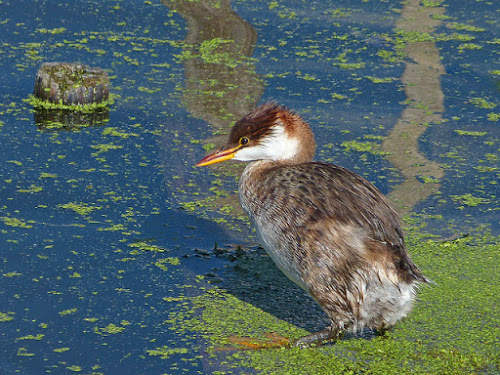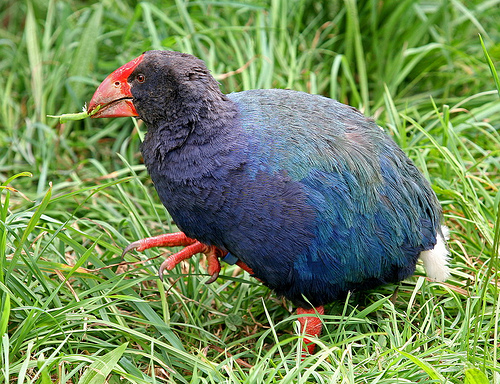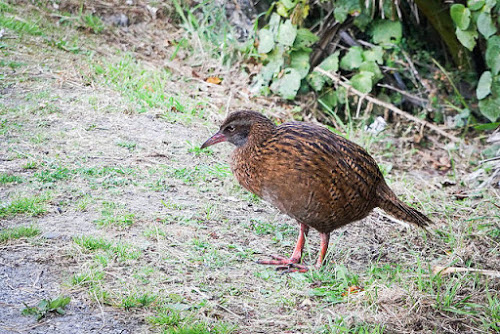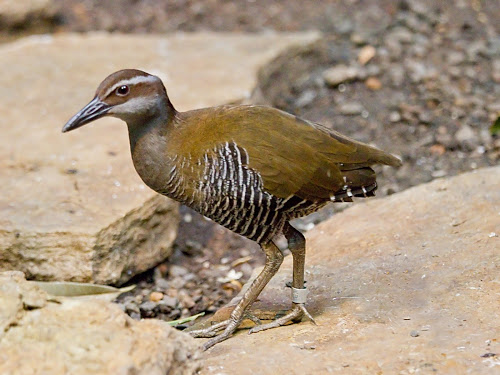These birds have wings but won”t fly! Surprised — then go scroll down the listto know more interesting facts about the world”s 10 most unusual flightless bird.
Titicaca grebe
The Titicaca flightless grebe or short-winged grebe (Rollandia microptera), is a grebe found primarily in Lake Titicaca which straddles the border between Peru and Bolivia. Though it can”t fly, it is an excellent diver. The upperparts of this flightless grebe are a black-brown colour. The chin, throat and foreneck are white. The nape is chestnut to dark sooty brown.
Takahē
The Takahē or South Island takahē (Porphyrio hochstetteri) is a flightless bird indigenous to New Zealand. The species was believed to be extinct by the end of the nineteenth century, but was rediscovered by Geoffrey Orbell in Fiordland in 1948. The takahē is still considered critically endangered with fewer than 300 individuals. This stocky bird with reduced wings is the largest living member of the Rallidae family. An adult measures 63 cm (25 in) and weighs about 2.7 kg (6.0 lb). It is generally purple-blue in colour, with a greenish back and inner wings. It has a red-based pink bill and pink legs.
Kiwi
The kiwi is any of five species of the non-flying family of birds called ratites native to New Zealand. Two of the species are vulnerable, one is endangered, and one is critically endangered. They can be found in different types of habitats: farmland, pine forest, scrubland, swamps, and vegetated gullies. The species is characterized by its round little body, brown fluffy feathers and its modest whiskered face. Its wings are only about 1 inch (3 cm) long and are useless, completely hidden under the feathers. Kiwis grow to about the size of a chicken and weigh between three and nine pounds.
Cassowary
The cassowary is a large, flightless bird distributed throughout Northern Australia, New Guinea, and surrounding islands. It is the heaviest bird in Australia and the second heaviest in the world after its cousin, the ostrich. There are three species of cassowary — the southern cassowary, the northern cassowary and the dwarf cassowary. All three cassowary species have a casque that starts to develop on top of their head at one to two years of age. Adults stand between 1.5-2 metres in height. Adults are striking with their jet black plumage and bright blue neck with touches of red.
Guam rail
The Guam rail (Gallirallus owstoni) is a flightless bird, endemic to the United States territory of Guam. The last individual in the wild of this species died in 1987 following catastrophic declines owing to predation by the introduced brown tree-snake. A captive population survives and is now being bred in captivity on Guam and at some mainland U.S. zoos. The species remains classified as Extinct in the Wild until an introduced population becomes firmly established.
It is a medium-sized rail about 28 cm in total length. The upperparts are chocolate-brown. The underparts are barred black and white. The head and back are brown. It has grey eyebrow, brown iris and a dark blackish breast with white barring. The legs and beak are dark brown.
Galapagos Flightless cormorant
The Galapagos Flightless Cormorant (Phalacrocorax harrisi) is one of the rarest birds in the world because it is the only cormorant that has lost the ability to fly. This cormorant is native only to the Galapagos Islands.
The unusual bird measures between 89–100 cm (35–40 in) in length and weighing 2.5–5.0 kg (5.5-11 lbs). The upper body plumage is blackish and the underparts are brown. It has elongated body, long neck, long, hooked bill, and short set-back legs with large, webbed feet.
Tasmanian nativehen
The Tasmanian nativehen (Tribonyx mortierii) is a stocky flightless bird found only in Tasmania. Although many flightless birds have a history of extinction with the arrival of humans, the Tasmanian nativehen has actually benefited from the introduction of European style agricultural practices that provide easy food for grazing. Although they cannot fly, they are good swimmers and very fast runners. They have been clocked at up to 30 miles per hour.
It stands between 43 and 51 centimetres (17 and 20 in) in length. The upper body is olive brown with a white patch on the flank. The underparts are darker with a bluish grey tinge. The bill is a greenish yellow colour. The short tail and abdomen are black.
Campbell teal
The Campbell teal (Anas nesiotis) is a small, flightless, nocturnal species of dabbling duck endemic to the Campbell Island group of New Zealand. Both sexes are sexually dimorphic in plumage and size. Females are a uniformly dark brown with a paler abdomen, while males have a green, iridescent head and back, with a chestnut coloured breast. Both sexes have dark brown eyes, prominent white eye-patch, dark-grey bill, legs and feet. The Campbell teal is listed as Endangered because it has an extremely small population.
Kakapo
The Kakapo (Strigops habroptilus), also called owl or night parrot, is a very unusual bird found only in New Zealand. It is the world”s rarest, heaviest, and the only flightless nocturnal parrot. The species is known for its beautiful mossy green plumage mottled with brown and yellow. It has very soft feathers and an owl-shaped face. It has short legs, large grey beak, wings and feet. The tail is relatively short. An adult can measure from 58 to 64 cm (23 to 25 in) in length, and weight can vary from 0.95 to 4 kg (2 to 9 lbs). The Kakapo is critically endangered with only 126 known surviving birds as of March 2014.
Inaccessible Island rail
The Inaccessible Island rail (Atlantisia rogersi) is probably the coolest bird one should ever see – cool in a sense that it lives on an island that is literally inaccessible. This species, the smallest extant flightless bird in the world, is found only on Inaccessible Island in the Tristan Archipelago. Unlike many other islands, Inaccessible Island has remained free from introduced predators, allowing this species to flourish without threats.
The species is characterized by its short black bill, red eyes and greyish legs. It has dark rusty-brown plumage on its upper body and dark grey on underparts. It has an average length of 17 cm (6.7 in) and weight of 30 g (1.1 oz).










Amazing, it's nice to know something about this kind of flightless birds..that we always think that all birds can fly.
The only bird I'm familiar with would be the Kiwi. Although, they all look similar, don't they?
I remember those Guam rail when hubby took me to a short trip during my short stay in Guam.
i have birds at home…but not so familiar with these species 🙂
Very interesting write-up and run down of these species…I have seen kiwis, comorants and others but very neat to read up on the various types and what they can and have to do to survive without the aid of flight.